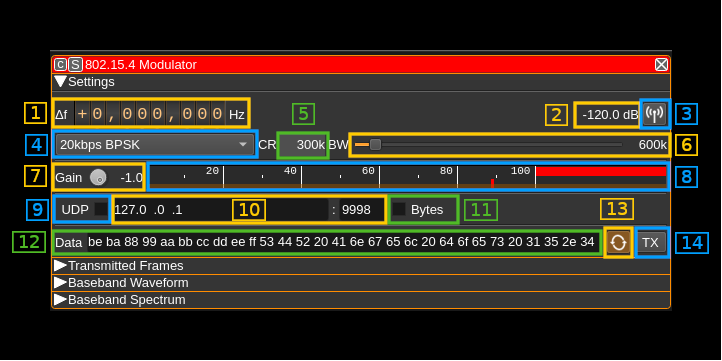readme.md
IEEE 802.15.4 modulator plugin
Introduction
This plugin can be used to transmit IEEE 802.15.4 frames. The 802.15.4 PHY & RF layers are used by networking layers such as ZigBee, 6LoWPAN and others.
Interface
The top and bottom bars of the channel window are described here
1: Frequency shift from center frequency of transmission
Use the wheels to adjust the frequency shift in Hz from the center frequency of transmission. Left click on a digit sets the cursor position at this digit. Right click on a digit sets all digits on the right to zero. This effectively floors value at the digit position. Wheels are moved with the mousewheel while pointing at the wheel or by selecting the wheel with the left mouse click and using the keyboard arrows. Pressing shift simultaneously moves digit by 5 and pressing control moves it by 2.
2: Channel power
Average total power in dB relative to a +/- 1.0 amplitude signal generated in the pass band.
3: Channel mute
Use this button to toggle mute for this channel.
4: PHY
This specifies the parameters of the PHY (physical layer), including the bit rate and modulation that is used for the frame transmission. Supported PHYs are 20kbps BPSK, 40kbps BPSK, 100kpbs <1GHZ O-QPSK, 250kpbs <1GHz O-QPSK and 250kbps 2.4GHz O-QPSK. These 802.15.4 PHYs use DSSS (Direct sequence spread spectrum), whereby multiple chips are transmitted per symbol. This means that a high baseband sample rate and large RF bandwidth is required. The baseband sample rate should be set to an integer multiple of the chip rate (at least 4x). Each PHY is applicable only for specific frequency bands as detailed below:
| Channel Page | Channels | Frequencies (MHz) | Bit rate (kbps) | Chip rate (kcps) | Modulation | Shaping | Min sample rate (MSa/s) |
|---|---|---|---|---|---|---|---|
| 0 | 0 | 868.3 | 20 | 300 | BPSK | RC r=1 | 1.2 |
| 0 | 1-10 | 906, 908... 926 | 40 | 600 | BPSK | RC r=1 | 2.4 |
| 0 | 11-26 | 2405, 2410... 2480 | 250 | 2000 | O-QPSK | Sine | 8 |
| 2 | 0 | 868.3 | 100 | 400 | O-QPSK | Sine/RC | 2.4 |
| 2 | 1-10 | 906, 908... 926 | 250 | 1000 | O-QPSK | Sine | 4 |
| 5 | 0-3 | 780, 782... 786 | 250 | 1000 | O-QPSK | RC r=.8 | 4 |
| 11 | 0-6 | 2363, 2368... 2393 | 250 | 2000 | O-QPSK | Sine | 8 |
| 11 | 7-13 | 2367, 2372... 2397 | 250 | 2000 | O-QPSK | Sine | 8 |
| 11 | 14 | 2395 | 250 | 2000 | O-QPSK | Sine | 8 |
5: Chip rate
This is the chip rate. It must be a multiple of the baseband sample rate and the baseband sample rate should be at least twice the chip rate. If one or both of these conditions are not met the background turns to red and the tooltip details the condition.
6: RF Bandwidth
This specifies the bandwidth of a LPF that is applied to the output signal to limit the RF bandwidth.
| PHY | Occupied BW (99%) |
|---|---|
| 20kbps BPSK | 400kHz |
| 40kbps BPSK | 760kHz |
| 100kbps O-QPSK | 330kHz |
| 250kbps <1GHz O-QPSK (Sine) | 1.2MHz |
| 250kbps <1GHz O-QPSK (RC) | 1.2MHz |
| 250kbps >2GHz O-QPSK | 2.6MHz |
7: Gain
Adjusts the gain in dB from -60 to 0dB. The gain should be set to ensure the level meter remains below 100% (see 8). If the baseband signal clips, this can lead to out-of-band spurious.
8: Level meter in %
- top bar (beige): average value
- bottom bar (brown): instantaneous peak value
- tip vertical bar (bright red): peak hold value
9: UDP input
Check to get data from UDP
10: UDP address and port
This UDP data packets listening address and port
11: Get data in bytes format
Check this if the data received is in bytes. When not checked data is expected in string format as blank separated hex bytes same as data below (12))
12: Data
The frame of data to send as hex bytes. For example, to send a MAC ACK frame, enter "02 00 00". The MAC CRC should not be included, as this is calculated and appended automatically.
In the diagram below this is the blue part without the "frame check sequence". Thus its maximum length is 125 bytes.
13: Repeat
Check this button to repeatedly transmit a frame. Right click to open the dialog to adjust the delay between retransmission and number of times the frame should be repeated.
14: TX
Transmits a frame containing the payload set in the data field. Right click to open a dialog to adjust transmission details allowing parameters different from standard values.
API
Full details of the API can be found in the Swagger documentation. Below are a few examples:
To transmit current data just send a "tx" action:
curl -X POST "http://127.0.0.1:8091/sdrangel/deviceset/1/channel/0/actions" -d '{"channelType": "IEEE_802_15_4_Mod", "direction": 1, "IEEE_802_15_4_ModActions": { "tx": 1}}
To transmit a frame from the command line:
curl -X POST "http://127.0.0.1:8091/sdrangel/deviceset/1/channel/0/actions" -d '{"channelType": "IEEE_802_15_4_Mod", "direction": 1, "IEEE_802_15_4_ModActions": { "tx": 1, "data": "02 00 00" }}'
To set the PHY to 20kbps BPSK:
curl -X PATCH "http://127.0.0.1:8091/sdrangel/deviceset/1/channel/0/settings" -d '{"channelType": "IEEE_802_15_4_Mod", "direction": 1, "IEEE_802_15_4_ModSettings": {"beta": 1, "bitRate": 20000,
"modulation': 0, "pulseShaping": 0, "rfBandwidth": 400000, "subGHzBand": 1 }}'

